

Only 21, singer/actress/paparazzi subject Selena Gomez has been in the public eye since her days as a regular on kid's TV. At times, she has been prone to intense internet scrutiny. In the last year, entertainment blogs had pointed out changes in her appearance. At occasional red carpet events, her face appeared swollen. Sometimes, a rash appeared on her neck or chest. When she canceled her concert tour late in 2013, the rumor factory went into full production mode. Was the “Come & Get It” singer’s swollen face due to plastic surgery or injection of cosmetic fillers? Was her rash some variation of “love bites” (hickeys)? Was she nixing her tour because of her on/off love life with fellow young adult heartthrob Justin Bieber?
Then the site Popdust released this posting:
“Sources close to the singer tell Popdust that Selena was diagnosed with lupus a couple of years ago and that she has suffered multiple “flares” recently, causing facial swelling, extreme fatigue, headaches and joint pain.”
If true, this would explain a lot. Okay, not the Justin Bieber thing, but the swelling, rashes and tour cancellation.
Then the site Popdust released this posting:
“Sources close to the singer tell Popdust that Selena was diagnosed with lupus a couple of years ago and that she has suffered multiple “flares” recently, causing facial swelling, extreme fatigue, headaches and joint pain.”
If true, this would explain a lot. Okay, not the Justin Bieber thing, but the swelling, rashes and tour cancellation.
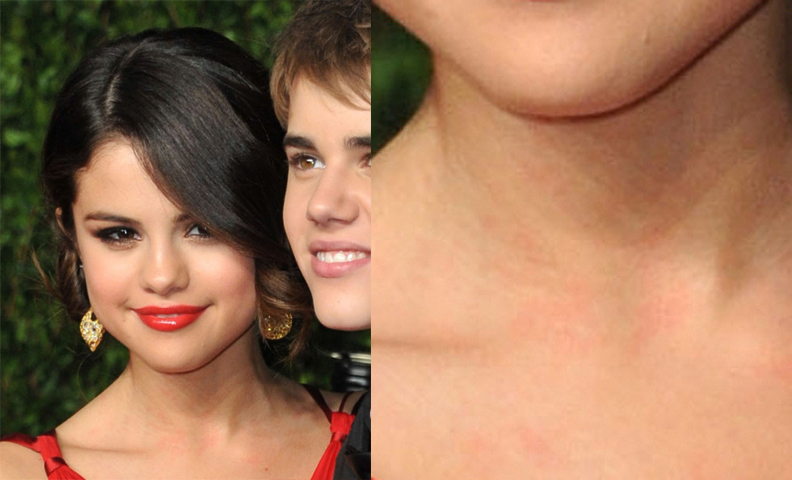
Lupus is due to an overactive immune response. Cells that should be fighting infection instead react against organs of the body. The skin, joints, lungs and kidneys can all be affected by this “auto-immune” condition. Gomez is in a likely demographic to contract the disorder. No, not because she is former child Disney star. Lupus is most commonly noted in females and has a higher incidence in Hispanics. While there are many theories as to why lupus strikes, the cause is unclear. The severity varies dramatically and the inflammation can come and go.
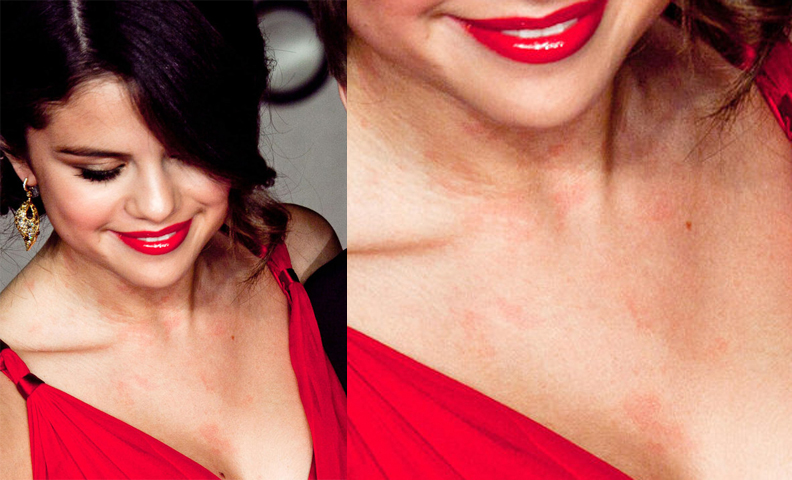
Lupus can cause variety of rashes. At an event on the arm of Bieber, Gomez has scattered blotchy red patches on her neck and chest. These may be stress hives (she is with the Biebs, after all!), but the rash of lupus is also possible. Hickies usually show a rougher, scratched appearance.

While there is no cure for lupus, there are treatments to reduce the inflammation. Predisone is a powerful prescription anti-inflammatory pill that can be used to control lupus. Unfortunately, the medicine has many side effects, including facial swelling. In these images, there is significant swelling of Selena's face on the right.

Note these images of Gomez, far right, at the 2012 VMA’s compared the previous events. Her face shows edema, facial swelling that could be a side effect of prednisone. This overall puffiness is not consistent with cosmetic filler injections.

Her bulging facial features cannot be blamed on generalized weight gain from binging on tasty Cronuts. Her body appears as slim as ever. Prednisone, which preferentially swells the face, is likely the cause.

The type and severity of lupus is extremely variable. Some have a mild form, while others need hospitalization. Singer Seal’s facial scars are due to a different form of the condition called Discoid Lupus (DLE). He suffered as a teen, leading to dramatic scars. His lupus has been in remission for years. Gomez, who likely has the systemic type of lupus, should not have the same potential for scars.

Talented and perky, we wish Selena Gomez the best. Since she survived the trials of being a teen pop star, she should have the strength to weather lupus as well.

Runner up: Pop Star Revelation: Toni Braxton is a Lupus Survivor.
If Gomez is truly prone to lupus, she can look to singer Toni Braxton as a role model. While shooting her show “Braxton Family Values,” Toni revealed to her family and the world that she had lupus. Here she receives an award for her work with a Lupus LA. No rash is seen. The course of lupus is more roller coaster than straight line, and it was reported that Braxton was hospitalized in late 2012 during a flare. She has asked that you “Un-break” her heart. We hope that researchers Un-cover the causes of lupus in the near future.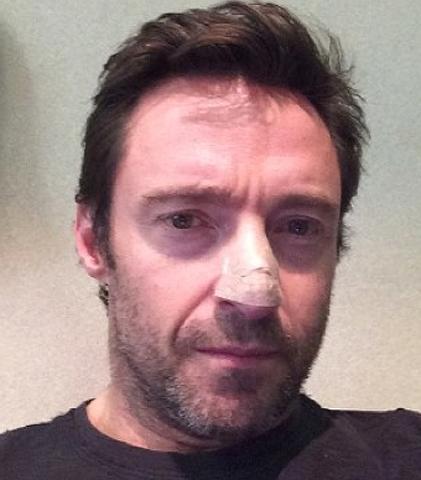

Followers of the X-Men franchise got a scare when screen sensation Hugh Jackman revealed that he had been treated for cancer. Before fans could get (Les) Miserable, Jackman reassured all that he had undergone successful skin surgery to remove basal cell skin cancer (BCC) from his nose. Jackman is the latest in a line of film icons to undergo treatment for facial BCC, including US President Ronald Reagan, 70’s era 007 Roger Moore and Cleopatra herself, Elizabeth Taylor.

Echoing the themes of Jackman’s upcoming X-Men flick, “Days of Future Past,” BCC results from chronic sun exposure from years before, likely from his upbringing in Australia. While dark black and irregularly shaped melanoma tends to get all the press, BCC is actually much more common, yet usually less worrisome. Melanoma can potentially spread to lymph nodes and metastasize. BCC tends to gradually get larger locally but otherwise stay put. If melanoma skin cancer is a dreaded Sharknado, consider BCC to be a pesky piranha.
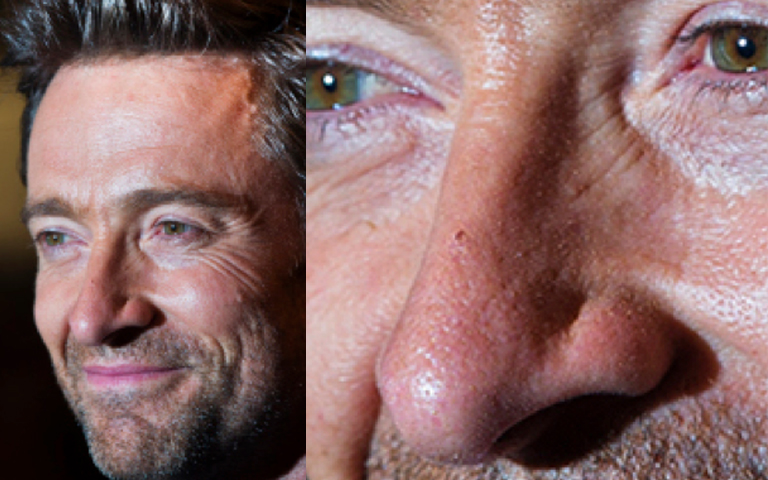
On Jackman's nose... ...a red patch with slight crust... ...the likely contour of his skin cancer.
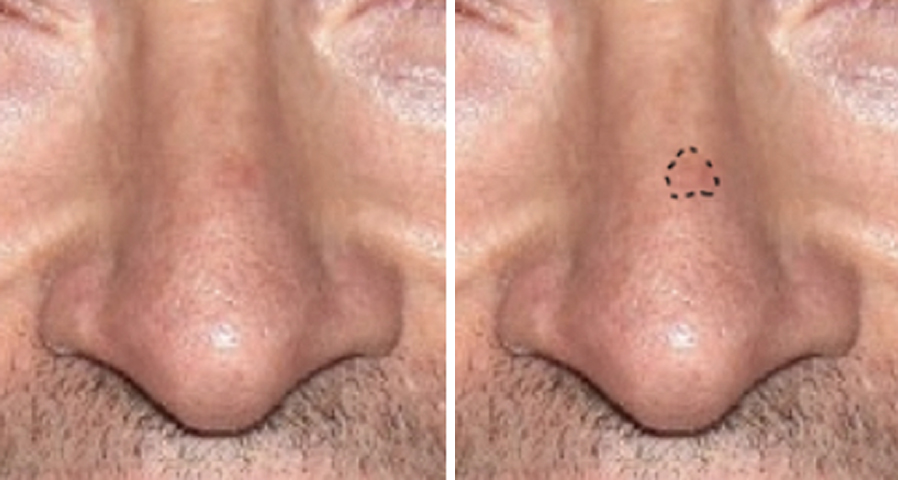
Probably the trickiest aspect of BCC is its subtle appearance. In these high res images taken at the Toronto Film Festival in September 2013, note slight redness and crust on Hugh’s nasal bridge. In this exclusive Skinema.com assessment, this images appear to be his skin cancer before treatment. Sometimes BCC can look shiny or pearly and may display thin scarlet blood vessels. If a skin lesion fails to heal over the course of weeks or months, consider BCC and have a dermatologist take a look.

Local surgical treatment is typically curative, just a few “Snikt”s from a dermatologist’s scalpel. Adamantium, the indestructible metal that makes up Wolverine’s claws, is not required. It is possible that Jackman underwent Mohs surgery. This procedure involves removing small amounts of tissue and then testing the specimen while the patient waits. Though time and labor intensive, the typical result is a smaller scar, important for any patient, not just a movie star. Kudos to Jackman for spreading the word about BCC and encouraging fair skinned folk to use sunscreen.

Runner up: Trending in Celebrity Skin Cancer: Singer Steve Perry Treated for Facial Melanoma
Former Journey lead singer Steve Perry has been blessed with an amazing musical career, belting songs like the Glee-rific “Don’t Stop Believing” that celebrate optimism. In 2013, via a fan site, Perry disclosed a health scare: A lesion on his right cheek was biopsied and found to be melanoma skin cancer. This dark and irregularly shaped lesion is likely the cancer, pre-treatment.
Presumably, the melanoma was superficial. Perry reports that he underwent two surgeries and was told that no further treatment was necessary. He made no mention of lymph node biopsies, a good sign. When caught early and excised, the prognosis for melanoma may be excellent.

He has every right to remain optimistic. "Don’t Stop Believing" and for the rest of you, "Don’t Stop Sunscreening."


In late 2013, talk show hosts and comedians got an early Christmas gift: Toronto mayor Rob Ford in the political definition of "Hot mess." Videos surfaced of Ford lighting up and inhaling from a glass pipe, the type typically used for smoking crack. Though he initially denied abusing the substance, he eventually relented, admitting “Yes, I have smoked crack cocaine but ... am I an addict? No. Have I tried it? Um, probably in one of my drunken stupors.” In addition to repeated gaffes at various press conferences, Ford’s appearance, balding, jowly, with a crimson face may have added to his being a satirical target.

SNL cast member Bobby Moynihan’s spoof specifically brought up this issue. When interviewed, Moynihan as Ford states “I feel like my public image is suffering because I don’t have any good photos so every time I’m in the news they show one where I’m all sweaty or red-faced or my neck is missing.”

Ford’s cherry-red face has become his own scarlet letter. Even Ford's bobble-head is blushing.

Though he admitted to drinking binges and the Toronto City Council voted to remove the majority of his powers, Ford has not publically agreed to step down or attend alcohol and drug rehab. Perhaps baby steps may be taken to address Ford’s public image melt down. He could start by reducing his facial redness.

Redness of the face has many causes, including genetic triggers, sun damage and the adult acne condition known as rosacea. The flushed appearance is typically related to the dilation of tiny superficial facial blood vessels. Mirvaso (Brimonidine) is a prescription topical gel that was approved by the US FDA in 2013. Within about a half hour after application, the gel blanches out dilated facial blood vessels. From beet red to normal skin tone, by using a drug that's entirely legal! The effect, while temporary, can last 9-12 hours, enough to get through several press conferences. A burning sensation and subsequent flushing are rare potential side effects. If one is prone other aspects of rosacea, such as swelling and pimples, other treatments may be required.

If Ford tried Mirvaso gel, the initial benefit to his appearance may lead to other healthy choices, in life and politics. We are not claiming it would be a cure-all for him. Mirvaso helps treat Red-face, but is not a therapy for any remaining conditions, such as Hot-head, Crack-head or S**t-face.

Runners up: In Need of Red-Faced Rehab: The Washington Redskins and Cleveland Indians mascots
Almost as controversial as Rob Ford’s shenanigans in 2013 is the persistent use of red-faced racially stereotypical football mascots. Chief Wahoo requires a societal shift, not just a topical gel.Dr. Reese and Skinema.com have no financial involvement with the makers of Mirvaso.


Mythic tales feature villains to vanquish. Tinseltown, the youth-obsessed purveyor of dreams and glamor, has a foe all its own. Wrinkles, long considered Public Enemy Number One for movie stars, are now on the run. In the last 20 years, the therapeutic options for facial beauty have exploded. Fillers, such as Restylane, Juvederm and Radiesse, restore volume and lift sagging features. Actress Nicole Kidman, shown in an image from her 2013 film, "Stoker", has wet eyes but no wrinkles. Are these tears of joy upon hearing about new cosmetic options?

Neuromodulators, like Botox, Dysport and Xeomin, reduce the lines created by years of frowning and squinting. Lasers zap blood vessels and sun spots. This veritable Avengers team of treatments vanquishes the effects of aging and sun exposure like Miley’s wrecking ball taking out a wall. The years burn away like this fiery image of actress Gwyneth Paltrow in "Iron Man 3." It's a happy Hollywood ending, crag-free, sag-free perpetual youth. The soundtrack swells, credits roll, and there’s no blooper reel in sight.

While that might work for a comic book popcorn flick, reality is more like an indie drama. Though movie stars bank on maintaining great looking faces, they are also expected to actually ACT. To portray characters that appear at least somewhat normal, with features that are not over-exaggerated and plastic, and facial muscles that move to express emotions. For several years, our site and many film critics and commentators have expressed concern about the facial changes of certain actresses in particular. For example, American-born, Australian-raised actress Nicole Kidman. Her frozen, expression-free forehead and puffed lips suggested overuse of Botox and fillers.

Finally, in January 2013, Kidman herself echoed those concerns. She told Italian newspaper La Repubblica: “No surgery for me; I did try Botox, unfortunately, but I got out of it and now I can finally move my face again.” Years of a flat brow seems to be more than just trying Botox, but admitting there is an issue can be the first step to recovery. This undated image shows the return of Kidman's frown.

In the Spring, fellow Oscar winner Gwyneth Paltrow stepped into the debate. In an interview with Harper’s Bazaar in April 2013, Gwyneth detailed her pursuit of various cosmetic treatments: "I'll try anything. Except I won't do Botox again, because I looked crazy. I looked like Joan Rivers!"

Not surprising, outspoken cosmetic devotee and comedienne Rivers responded: “She [Paltrow] should see what I look like without Botox. That’s really scary!” Rivers went on to more seriously point out: “I’ve always been open about what I do, because I want [women] to be able to get Botox and not look like a Shar Pei,” she said. “[Lying about having work done] is such a put down to women. It says to the average woman: ‘I’m beautifully naturally and you’re not.’” Full disclosure, the Shar Pei puppy is pictured on the right.
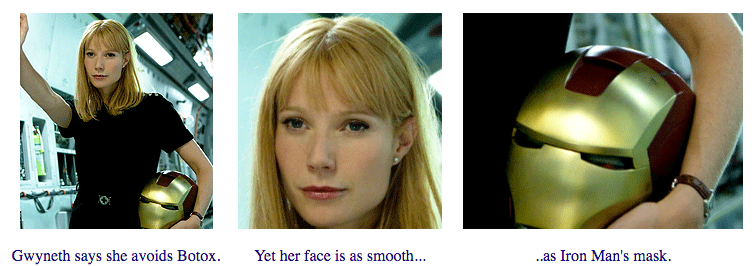
Gwyneth says she avoids Botox.
Yet her face is as smooth...
..as Iron Man's mask.

Is Gwyneth being honest about her short-lived use of Botox? In 1998's "Shakespeare in Love," Paltrow showed her Oscar-winning ability to furrow her brow. Now, her 41-year-old fair-skinned face is REMARKABLY wrinkle-free. Her current lack of frown lines reminds us of a classic quote from the Bard himself, "The lady doth protest too much, methinks."

While it is problematic to use Rivers as a voice of cosmetic reason, given her arguable overuse of plastic surgery, she has a point. Whether Gwyneth has had the Botox monkey on her back for years is not the issue as how little movie stars honestly reveal their history of cosmetic treatments.

We are not suggesting that Kidman and Paltrow ban Botox from their brows or fillers from their faces. The widely used treatments have been shown to be safe over the long term. Conservative use of Botox can reduce wrinkles and yet still allow for facial expression. There is really nothing wrong with wanting to look your best, as long as the results don’t appear abnormal or plastic. Wrinkles don’t have to be the ultimate evil. Like a nuanced film performance, beauty management is a balancing act. We look forward to Nic’s and Gwyn’s success in continuing to walk the cosmetic high wire.

Runner up: Cosmetic Controversy of the Year: No one complains about lip fillers?
While Kidman and Paltrow dissed Botox, puffy lips can look just as unnatural on-screen. We applaud Jennifer Garner’s supporting role in “Dallas Buyer’s Club.” We just wish her lip filler wasn’t so distracting!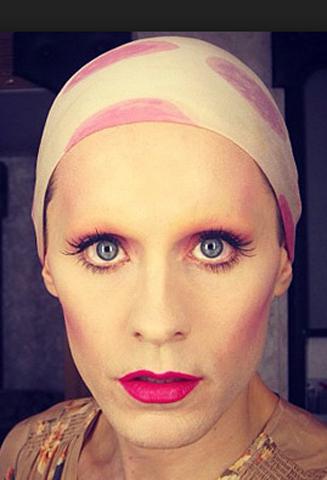

As an HIV positive transvestite in “Dallas Buyer’s Club,” actor Jared Leto is getting well-deserved Oscar buzz. The film is set in the late 1980’s, at the dawn of treatments for AIDs. Leto works with HIV infected cowboy/ entrepreneur Matthew McConaughey to rustle up and sell non-FDA approved treatments.
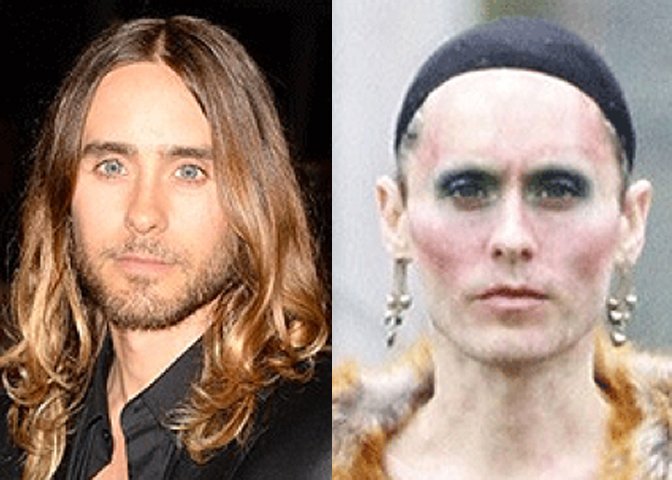
Leto lost significant weight and sheared his flowing locks to protray this spunky character. Leto and the film itself are already winners here at Skinema.com for depicting his Kaposi’s Sarcoma (KS) realistically and sympathetically. Usually, when makeup or CGI is used to create the appearance of abnormal skin, the effect is to illustrate evil. Think Freddie Krueger, Scarface or various Bond villains. Leto’s character is not portrayed as evil, rather as a flawed but feisty faux femme. He and McConaughay navigate an antagonistic bureaucratic system, fighting not just for their survival, but for others with the disease.
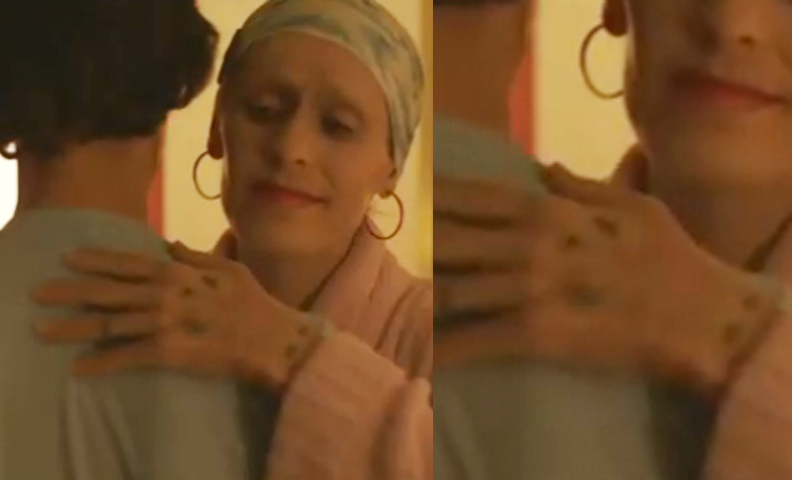
Kaposi’s Sarcoma is a form of blood vessel cancer. It can be deep red or purple, as seen here. We now know that it is the result of infection with the human herpes virus 8 (HHV-8), which is separate from the viruses that cause AIDs (HIV) and lip and genital herpes (HSV). While many may harbor HHV-8, healthy immune systems keep the virus suppressed. Infection with HIV damages the immune response, allowing bruise-like lesions to develop on the skin and internal organs. Now with treatments for HIV, it is possible to put KS into remission. Because of this, KS is much less common since treatment for HIV has become available.

In the movie, the presence or absence of KS lesions are used to show patients either responding to treatment or succumbing to AIDS. Of interest, we are aware of no movies that have used KS to identify a purely malicious character. Oscar winners who have had roles featuring KS include Tom Hanks, Al Pacino, Angelina Jolie and Javier Bardem.

While there has been, and continues to be ignorance about and prejudice directed toward those infected with HIV, film makers have consistently depicted complex individuals coping with a life-threatening condition. Props to Leto and “Dallas Buyers Club” for continuing this tradition.
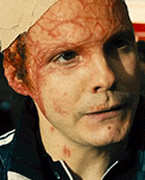
Runner up: Skin Lesions That Induce Empathy: Daniel Brühl's scars in “Rush”
In Ron Howard’s flick about actual 1970’s Formula One drivers, Daniel Brühl plays Niki Lauda, dramatically burned during a racing accident. Though Lauda's social skills do not match his ability on the track, he is not portrayed as wicked or immoral.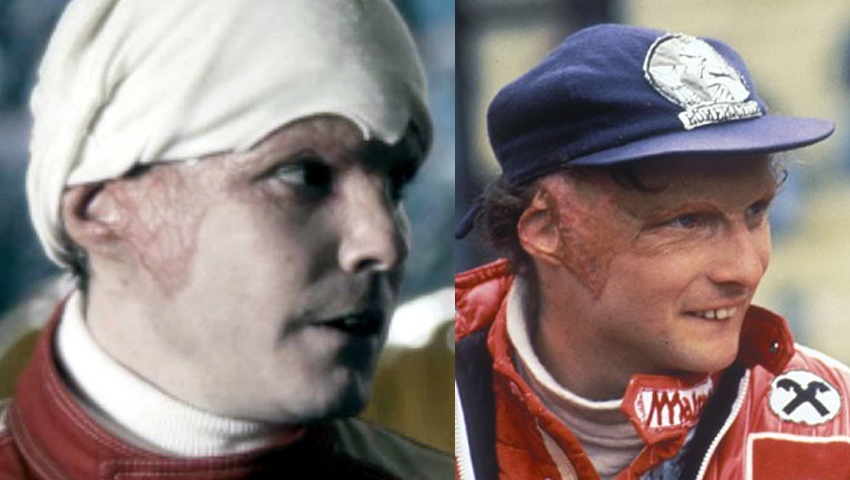
His survival instinct, ambition and tenacity generate cheers from the crowds. Note also, the accurate depiction of Lauda's deformity. Actor Brühl is on the left and Lauda himself is shown to the right. Brühl finishes this race with a worthy second place on the Skinema podium.


Warning: The TV phenomenon “Scandal” re-defines the phrase “Spoiler Alert.” What follows are minor spoilers to anyone who has not binge-watched the series past the end of the second season. For all others, you “can handle it.”

In “Scandal,” Kerry Washington’s Olivia Pope is a force. As a “handler” of political and celebrity transgressions, Pope and her team of legal and media-savvy “Gladiators” manage to navigate increasingly complex Capitol Hill crises. She seems to have all of DC under her thumb, including her hunky adulterous love puppy, President Fitz. She manages to master all media, while never spilling a drop of red wine on her ivory-colored couture wardrobe. Until the end of the show’s second season, it seemed no one could resist or intimidate “Liv.”

Enter veteran actor Joe Morton as Rowan, the sinister head of a clandestine shadow government agency called B613. Not only does Rowan appear to frighten various veteran agent and politicos, he even has Olivia shaking in her designer boots. Then, reminiscent of Star Wars, it is revealed that he is Liv’s father.

The similarities to Darth Vader do not end there. For much like the baddie daddy Sith Lord, whose dramatic scarring telegraphs an evil nature, actor Morton has his own marker of malevolence: a prominent birthmark.

On Morton’s left cheek resides a large, round, evenly colored dark nodule. Not the creation of Hollywood prosthetic makeup, this lesion has been apparent for all of Morton’s life, as recorded in images from his entertainment career.

Yes, on the left that’s Morton and his mole in the 1984 Sci-Fi indie, “Brother from Another Planet.” His birthmark is seen again (R) in the blockbuster “Terminator 2: Judgment Day.” (1991)

Birthmarks are collections of similar skin cells that group together during pregnancy. Most birthmarks are not dangerous, but some may eventually turn cancerous. Fortunately, Morton’s birthmark shows all of the characteristics of a benign lesion. Moles are worrisome if they are irregular in color or shape. Morton’s mark has become slightly more raised over the years, normal for this type of facial mole.
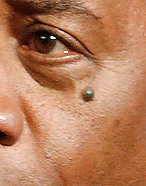
Some entertainers desire the cosmetic removal of birthmarks. Arnold Schwarzeneggar, Morton’s “T-2” costar, had a neck birthmark terminated after his first few films. Clearly, Morton’s lesion has not slowed his career. In fact, Morton’s mark might be considered his logo, brand, even capable co-star. Also, to entirely remove the lesion would involve scarring more dramatic than the usual “Scandal” cliffhanger. So the ultimate “Fixer” Olivia Pope can relax. Her TV dad’s birthmark is one less thing to be fixed. His actions are another story...

Runner up: Most Scandal-lous Birthmark: Rebel Wilson’s extra nipple?
The “nip-slip” remains the not-so-holy grail for many paparazzi. Their childrens' college funds depend on capturing a titillating view (pun intended) of a starlet’s nipple. Imagine their surprise when Aussie comedienne Wilson revealed not just one nip, but two on the same breast. Yet another accessory nipple to add to the skinematic collection. In this case, both were phony. Controversy cleared, in the nip of time!
One doesn’t need perfect skin to be in the movies. There are countless SAG members with acne scars, sun spots, injury scars and wrinkles. They are consistently cast in minor roles, comedic parts and as villains or thugs. Known as character actors, they lend some visual reality to screen stories.

But leading men? Usually these handsome specimens are hired for their jut jaws, trim physiques and clear skin. Movie stars like George Clooney and Leonardo DiCaprio exist to be desired and admired. Audiences may put up with a small chicken pox scar or two, but otherwise like their beefcake blemish-free.

This awards season, two actors are making the awards show rounds. Each carries his respective feature film, appearing in a majority of the movies’ scenes. And both display facial skin issues nearly as dramatic as their performances.

Robert Redford is long past his days as a matinee idol, but in his 77th year, he is hanging in there. Especially in the acclaimed “All Is Lost,” where he hangs on the riggings of a boat adrift at sea. Looking at Redford’s grizzled visage, it doesn’t take Sherlock Holmes to deduce what was “Lost”: Sunscreen, my dear Watson.

As a star during the tan-happy 1970s, Redford had as much ultraviolet (UV) exposure as he did box office success. On the left he is battered by damaging sunlight yet seem unaware of any problem as "The Great Gatsby" (1974). Years later, his characters are still sun exposed. It pains us to think that Redford spent months under the hot sun filming this latest feature, right. Aquatic activities markedly increase the sun’s power to damage the skin. The light's reflection off the water represents a double whammy. The photons are to be feared, not embraced, and Redford’s skin shows the results of years of exposure.

Despite the claims of the tanning bed industry, one does not need to suffer blistering sun burns to accrue damage. Redford provides a veritable dermatology atlas of the effects of chronic sun exposure.

UV damages collagen causing both fine wrinkles and deeper furrows. Sunlight causes sun spots, large blotchy freckles that few find fetching. Superficial blood vessels dilate causing a ruddy appearance.
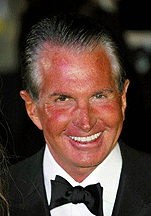
Redford has not gone on record to report precancerous changes or skin cancer. George Hamilton is another actor from Redford’s era who has promoted tanning as a lifestyle choice. Recently, "Hamil-tan" admitted that he had undergone treatments for precancerous skin lesions related to sun damage. Fortunately for most fair-skinned movie-goers all is NOT lost. Using sun protection, at least SPF 15, reapplying every few hours, avoiding the midday rays and shunning tanning beds has been proven limit these changes over time.

We are aware of a number of movie actors with traumatic scars, including Harrison Ford, Sandra Bullock and Tina Fey. Yet British screen star Chiwetel Ejiofor has the most prominent and dramatic injury scarring that may have ever graced a leading man.

The result of a tragic car crash when Ejiofor was only 11, the jagged, raised scars might have made Ejiofor avoid the spotlight. In movies, this type of scarring would usually adorn an evil character.
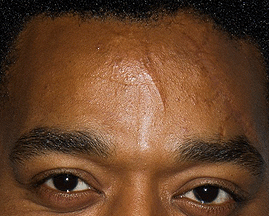
To Ejiofor’s credit, of his 30 or so major film roles, most were depicting heroic or sympathetic characters. Of note, Ejiofor’s heartbreaking performance of a kidnapped and enslaved free black man in “12 Years A Slave” does not highlight or focus on his scars.

Though partially hidden by a 1970’s-style ‘stache, Phoenix has a prominent scar on his upper lip. This has been present since birth, presumably a cleft lip defect that repaired itself in utero. Much like Phoenix has salvaged his movie career in “Her.”
« Back




